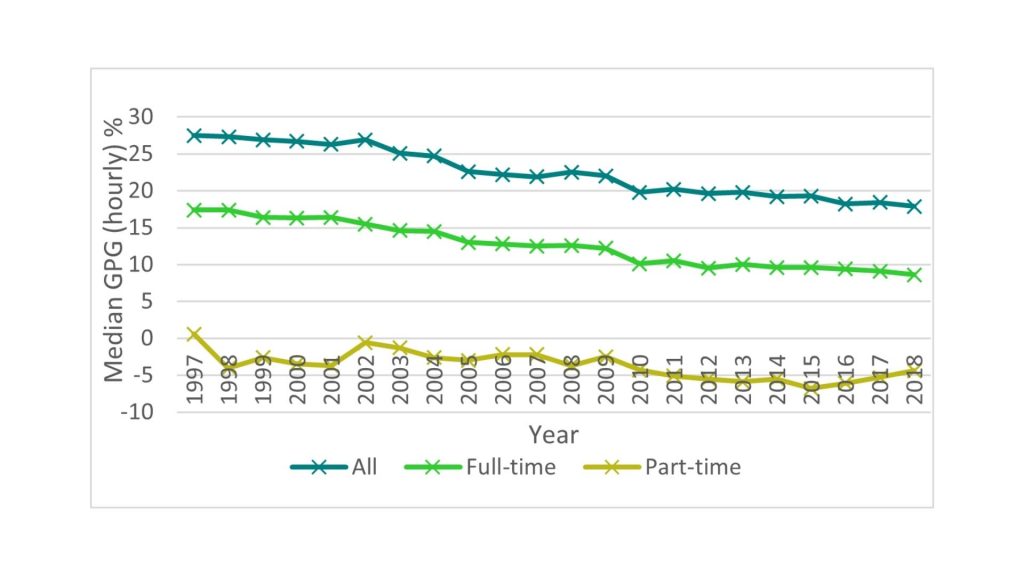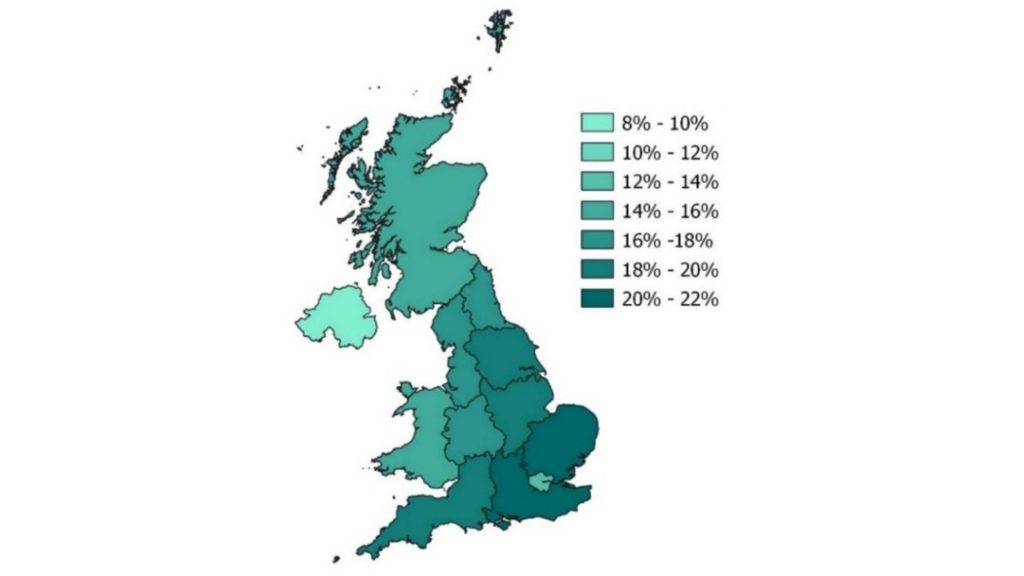Why does the Gender Pay Gap vary across Wales?
5 March 2021
In our latest post, doctoral student Suzanna Nesom discusses findings from her literature review on the Gender Pay Gap in Wales.
The Gender Pay Gap is the difference in earnings between women and men, determined by calculating women’s average pay – usually measured hourly to adjust for hours worked – as a percentage of men’s.
It’s a persistent feature of the UK labour market, with the median UK Gender Pay Gap in 2019 estimated to be 17.3% for all employees. While this is relatively large compared to other Organisation for Economic Co-operation and Development and EU countries, it has slowly declined since 1996 for all, full-time and part-time employees (figure 1).

Data: ASHE and NES
The UK Gender Pay Gap exhibits a regional dimension (figure 2). It is smallest in the devolved nations and London, and largest in the English regions closest to London.

Data: ASHE (2019)
There’s also a regional dimension to the Gender Pay Gap in Wales. The median (mean) Gender Pay Gap for all employees in Wales ranges from 7.9% (0.7%) in Conway and Denbighshire, to 21.1% (19.9%) in the Central Valleys.
The Welsh legislative environment

The Gender Pay Gap has recently received significant policy attention, not least in the UK. In 2017, the UK enacted wage transparency regulations that require public and private sectors employers with more than 250 employees to annually publish six measures of the Gender Pay Gap within their organisations. The enforcement of Gender Pay Gap reporting for 2019/20, though, was suspended due to the Coronavirus pandemic.
Since devolution, Wales has a distinct equality agenda, including a Welsh specific statutory duty to address pay differences. The Welsh legislative environment is also more conducive to tackling the Gender Pay Gap, with the Well-being of Future Generations Act 2015, Prosperity for All: the national strategy 2017, and the work of the Fair Work Commission 2019.
Researching the Gender Pay Gap
There are three main economic methodologies to researching the Gender Pay Gap:
- Mincer wage equations: These relate the amount of schooling and work experience (and other observable characteristics) to an individual’s wage. However, as gender is included as a binary variable (being either male or female) it seems removed from the feminist argument that gender attributes are not fixed or stable across time.
- Decomposition methodologies: These decompose the Gender Pay Gap into a part explained by gender differences in observable characteristics and a part unexplained, representing differences in the return to those variables. This is often taken as a measure of discrimination. Extensions of this methodology can facilitate the decomposition of the Gender Pay Gap across countries and time periods, into occupational components, and for different quantiles in the wage distribution.
- Experimental Methodologies: These simulate decisions through presenting participants with hypothetical hiring scenarios and manipulating protected-group status for otherwise identical job candidates.
Influencing the size of the Gender Pay Gap
Empirical research on the Gender Pay Gap is vast, enhancing our knowledge of the multifaceted sources of it. Cross-country comparisons and in-depth national and regional studies identify several key drivers influencing the size of the Gender Pay Gap, including:
- Institutions: Countries with centralised institutions (e.g. strong trade unions) and high national minimum wages are associated with lower Gender Pay Gaps. However, the UK’s minimum wage only decreased the Gender Pay Gap in regions where women comprised a large share of the low paid.
- Legislation: Legislative differences are key sources of Gender Pay Gap variation, with ‘generous’/liberal childcare policies associated to lower mean Gender Pay Gaps (e.g. Denmark and the Netherlands).
- Wage Structure: High levels of wage inequality is associated with large Gender Pay Gaps. At the regional level, this is mainly driven by variation in men’s wages – women’s wages are relatively stable across regions.
- Education: Educational differences explain very little of the UK Gender Pay Gap, due to women consistently outperforming men at all levels of education. However, gender differences in degree subject impacts the Gender Pay Gap, as women are more likely to study subjects associated with unemployment, over-education, and lower average pay.
- Work experience: Women’s reduced years of work (often due to taking time out for children or other caring responsibilities) is a large driver of the Gender Pay Gap. Productive characteristics are rewarded at a lower rate for part-time women compared to their full-time counterparts.
- Occupational Segregation: Women are more likely to work in female-dominated occupations, which typically pay less than male-dominated occupations.
- Labour market discrimination: UK anti-discrimination legislation has generally reduced discrimination. However, the large unexplained part of the Gender Pay Gap in the public sector questions the extent to which the extra Public Sector Equalities Duty is effective.
- Psychological traits: Gender differences in traits (e.g. self-esteem and control) do not explain much of the UK Gender Pay Gap, although other traits (e.g. cognition/self-confidence) may explain more but are unexplored.
- Structures of regional markets: Regions without large firms providing high-paid jobs in manufacturing (mainly for men) tend to have a low or negative Gender Pay Gap.
Future Research Agenda
Whilst we know a lot about what influences the Gender Pay Gap at the national level, analysis at the regional level is currently missing. I hope to use the methodologies outlined above and Wales as a case study to provide new evidence to address this gap, as well as quantitatively measure the effectiveness of different policies to tackle the gender pay gap, and the impact of different national/devolved policies on the Gender Pay Gap.
Suzanna Nesom is a doctoral student at Cardiff Business School.
Her PhD is funded by the Economic and Social Research Council and in collaboration with Chwarae Teg (Wales’ leading women’s charity). She’s researching why the Gender Pay Gap varies so much across local authorities in Wales. The project is supervised by Professor Melanie Jones and Dr Ezgi Kaya and proceeds their research on the Gender Pay Gap in the UK Public Sector and in Northern Ireland.
Previously Suzanna worked on the Welsh Government’s Gender Equality Review with Chwarae Teg.
- March 2024
- April 2023
- August 2022
- July 2022
- April 2022
- March 2022
- February 2022
- December 2021
- October 2021
- September 2021
- May 2021
- April 2021
- March 2021
- February 2021
- January 2021
- December 2020
- November 2020
- October 2020
- September 2020
- August 2020
- July 2020
- June 2020
- May 2020
- April 2020
- March 2020
- February 2020
- January 2020
- November 2019
- October 2019
- September 2019
- August 2019
- July 2019
- June 2019
- May 2019
- April 2019
- March 2019
- February 2019
- January 2019
- December 2018
- November 2018
- October 2018
- September 2018